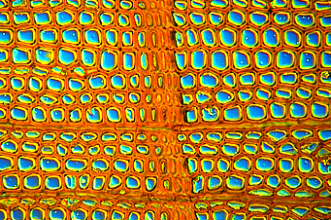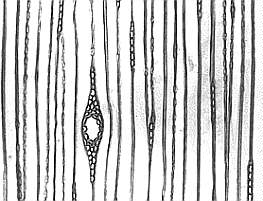
Gymnosperm wood is more homogeneous than that of angiosperms. Its only conducting elements are tracheids. Just like the wood of angiosperms, it is interspersed with radially orientated rays (medullary rays) consisting of parenchyma cells and sometimes also tracheids.
The wood of gymnosperms is simpler and more homogeneous than that of angiosperms. Except for the species of the order Gnetales, tracheids are the only conducting elements in gymnosperms. The most important insights into the structure and formation of pine wood that is always regarded as the prototype of gymnosperm wood stem from the German KARL SANIO (1832-1891). His observations were completed by the studies of the American botanist I. W. BAILEY (1954). SANIO assumed (1872/73) that "... the bast (phloem) and wood cells of one radial row develop from a single cell of the cambium by alternate divisions". This observation is one of the first and most important concerning the cambium's impact on secondary growth. The processes within angiosperm wood are in principal the same, but it was at first by no means simple to recognize the logical connection. Pinus silvestris or related species like the North American white pine (Pinus strobus) turned out to be ideal specimens. Pine wood is a typical object of every botanical ground course. Since cells and tissues are three-dimensional objects, they do have to be regarded from three sides to get an impression of their spatial organization:
![]() cross-section
cross-section
![]() radial longitudinal section
radial longitudinal section
![]() tangential section.
tangential section.
These three perspectives can be combined in a diagram. For some years now, scanning electron microscopy has been used in the examination of the three-dimensional structure of wood.
The maybe best-known property of gymnosperm- and angiosperm wood beside the annual rings is the grain, that is visible especially nicely in tangential sections. The veneers often used in the fabrication of furniture are made from such sections.
 Annual
rings> are well-suited for the
determination of the trees' ages. As we have already seen, their
thickness depends on many factors. During the 1980th, the
14C method has been established. It is based on the fact
that in every carbon-containing compound (like lignin) not only the
normal carbon isotope 12C is found, but also, in much
lower amounts, the radioactive isotope 14C. The
14C/12C ratio of the atmosphere is
1:106. 14C has a half-life of 5770 years. No
new carbon is incorporated into an already finished compound so that
its 14C content sinks continuously. The ratio of
14C/12C shifts thus in favour of
12C. Some several thousand year old Californian
Sequoia- and Pinus aristata-trees turned out to be the
ideal specimen to test the precision of both methods and to calibrate
one with the help of the other.
Annual
rings> are well-suited for the
determination of the trees' ages. As we have already seen, their
thickness depends on many factors. During the 1980th, the
14C method has been established. It is based on the fact
that in every carbon-containing compound (like lignin) not only the
normal carbon isotope 12C is found, but also, in much
lower amounts, the radioactive isotope 14C. The
14C/12C ratio of the atmosphere is
1:106. 14C has a half-life of 5770 years. No
new carbon is incorporated into an already finished compound so that
its 14C content sinks continuously. The ratio of
14C/12C shifts thus in favour of
12C. Some several thousand year old Californian
Sequoia- and Pinus aristata-trees turned out to be the
ideal specimen to test the precision of both methods and to calibrate
one with the help of the other.
The xylem of gymnosperms has few or no parenchyma cells at all. Their existence (or non-existence) is a feature of certain genera. With Pinus, they are found only in the epithelia of resin ducts, with many Podocarpaceae, Taxodiaceae and Cupressaceae (cypresses), they are amply present, while they are missing completely with Araucariaceae and Taxaceae (yews).
The tracheids of gymnosperms are 0.5-11 mm long and are orientated along the shoot or root axis. They border at neighbouring tracheids above and below not with their final walls, but with the ends of their lateral walls. This is the reason, why there are never, neither in tracheids nor in vessels, ideal, vertical conducting tubes.
In many species, it is distinguished between sapwood and heartwood. Sapwood is an active, water-conducting tissue, while heartwood is inactive and has only supporting functions. Its cells contain but little water or reserve compounds. Instead, organic compounds, oils, rubber, resins, tannic acids, dyes or aromatic compounds are stored here. Oxidized phenolic compounds give the wood a dark colour. The typical heartwood is missing in spruce (Picea excelsa), pine (Abies alba) and in some angiosperms (poplar, willow). These woods are regarded as less valuable by the timber industry than heartwood-containing ones.
 Medullary
rays Wood is at regular distances
interspersed with radially orientated parenchyma cells and often also
with tracheids. They spring from the
ray
initials> of the cambium. The medullary
rays of conifer wood are normally only one cell layer thick, but they
can be as high as 1-20 (sometimes even up to 50) layers of cells. Ray
tracheids and axially orientated tracheids are connected via
pits.
Medullary rays with resin ducts seem spindly in tangential sections.
Resin
ducts can be either axially or radially
orientated. There is actually hardly any difference between them and
intercellular spaces that have been enlarged by the splaying of
parenchyma cells. Consequently, resin ducts are always lined with
parenchyma cells. Their existence has different reasons: injuries by
frost or winter damages are some factors that stimulate their
formation. The respective gymnosperm families react differently to
these disturbances.
Medullary
rays Wood is at regular distances
interspersed with radially orientated parenchyma cells and often also
with tracheids. They spring from the
ray
initials> of the cambium. The medullary
rays of conifer wood are normally only one cell layer thick, but they
can be as high as 1-20 (sometimes even up to 50) layers of cells. Ray
tracheids and axially orientated tracheids are connected via
pits.
Medullary rays with resin ducts seem spindly in tangential sections.
Resin
ducts can be either axially or radially
orientated. There is actually hardly any difference between them and
intercellular spaces that have been enlarged by the splaying of
parenchyma cells. Consequently, resin ducts are always lined with
parenchyma cells. Their existence has different reasons: injuries by
frost or winter damages are some factors that stimulate their
formation. The respective gymnosperm families react differently to
these disturbances.
|
|